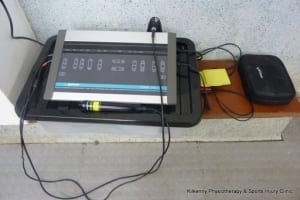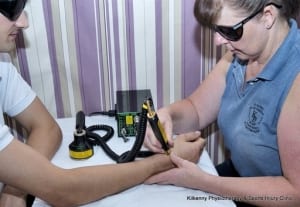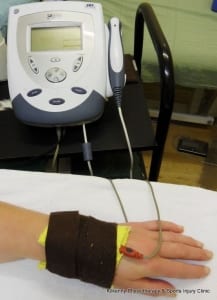Home / Treatments Offered / Electrotherapy
Recently electrotherapy treatment for sports and other injuries has gone out of vogue. When I qualified it was very much in vogue. I feel it is another tool, in my very large Toolkit, which I can use to enhance the healing process of any injury.
Lack of Research and Advent of New Treatments
Lack of Research into benefits of electrotherapy
In the area of acute injuries it is hard to get good extensive studies to reliably prove or disprove a theory, there are so many variables – the method of selection, eg who diagnosed the conditon, the alternatives used, the experience of the practitioner doing the research, the compliance and mental state of the subject etc.
So in a lot of cases electrotherapy is not being advocated because there is not enough research to prove it’s worth, rather than there is too much research to disprove it.
One research method which is rarely published is the experience of individual practitioners and their patients’ experiences. Personally I see a place for electrotherapy in conjunction with other therapies and treatment approaches.
Advent of new physiotherapy treatment approaches
The advances made in the areas of manual hands on therapy, exercise prescription, strength and conditioning and self management have been huge in the last 20 years, and so there is less need for the use of electrotherapy.
In our clinic we keep up to date with research based practice and incorporate all the elements of physiotherapy int our practice.
Electrotherapy is the use of electrical devices to have a positive effect on the healing of the body. It may be through electrical stimulation, sound wave oscillation or light absorption.
In our clinic we use a number of different electrotherapy modalities.
Ultrasound for physiotherapy
This is the use of sound waves to promote healing by reducing swelling, reducing pain, releasing myofascial trigger points and muscle tightness and improving circulation. It can be alikened to micro massage at a cellular level.
This machine has potential harmful effects if used incorrectly. There are very strict guidelines for its use in growing certain areas of the population and certain areas of the body.


Electrotherapy machine at Kilkenny Physiotherapy & Sports Injury Clinic


Electrotherapy at Kilkenny Physiotherapy & Sports Injury Clinic
Laser Therapy for Physiotherapy
Uses Light energy which is absorbed by the cells and has the effect of increasing the cells’ own ability to heal. It is particularly useful as it has aids the body’s natural healing process and so can be used with in the first 24 hours after injury, when other treatments are to be avoided.
Biofeedback
Uses electrical stimulation of a muscle to the point of contraction so that a patient can learn to recognise how to use a muscle which has been inhibited through injury and wastage or has been neurolgically damaged.
Neuromuscular Stimulation in physiotherapy
Used to stimulate the nerves supplying muscles. It can be used to stimulate nerves and strengthen muscles, or can be used in a relaxation mode to reduce muscle spasm and soreness.
It can also be used as a bio feedback tool.
Interferential Therapy in physiotherapy
There are many uses from pain reduction and inflamation reduction to muscle facilitation. It is based on the interference of two electrical currents producing a physical effect in the cells of the body


Transcutaneous Nerve Stimulation in physiotherapy (TENS)
This is commonly known as TENs and acts on pain pathways to reduce pain. It is a passive type of non chemical and non invasive form of pain relief which many people will use at home.
It is widely recognised and known for its benefits during labour.
Vibration Therapy
Although not technically an electrotherapy modality we sometimes use a vibrational massage hammer as a tool to release muscle tightness
MONDAY – FRIDAY
8am – 9pm
SATURDAY
9am – 2pm
SUNDAY
Closed